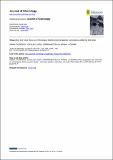Files in this item
Stagnation and mass loss on a Himalayan debris-covered glacier: processes, patterns and rates
Item metadata
| dc.contributor.author | Thompson, Sarah | |
| dc.contributor.author | Benn, Douglas I. | |
| dc.contributor.author | Mertes, Jordan | |
| dc.contributor.author | Luckman, Adrian | |
| dc.date.accessioned | 2016-08-16T12:30:11Z | |
| dc.date.available | 2016-08-16T12:30:11Z | |
| dc.date.issued | 2016-06-01 | |
| dc.identifier | 245054205 | |
| dc.identifier | bff7cd92-3554-499e-b182-f597e257e984 | |
| dc.identifier | 84979697055 | |
| dc.identifier | 000381452400004 | |
| dc.identifier.citation | Thompson , S , Benn , D I , Mertes , J & Luckman , A 2016 , ' Stagnation and mass loss on a Himalayan debris-covered glacier: processes, patterns and rates ' , Journal of Glaciology , vol. 62 , no. 233 , pp. 467-485 . https://doi.org/10.1017/jog.2016.37 | en |
| dc.identifier.issn | 0022-1430 | |
| dc.identifier.other | ORCID: /0000-0002-3604-0886/work/64697403 | |
| dc.identifier.uri | https://hdl.handle.net/10023/9312 | |
| dc.description | This research was supported financially by the University Centre in Svalbard (UNIS), National Geographic Society GRANT #W135-10, The Natural Environmental Research Council and the European Commission FP7-MC-IEF. | en |
| dc.description.abstract | The ablation areas of debris-covered glaciers typically consist of a complex mosaic of surface features with contrasting processes and rates of mass loss. This greatly complicates glacier response to climate change, and increases the uncertainty of predictive models. In this paper we present a series of high-resolution DEMs and repeat lake bathymetric surveys on Ngozumpa Glacier, Nepal, to study processes and patterns of mass loss on a Himalayan debris-covered glacier in unprecedented detail. Most mass loss occurs by melt below supraglacial debris, and melt and calving of ice cliffs (backwasting). Although ice cliffs cover only ∼5% of the area of the lower tongue, they account for 40% of the ablation. The surface debris layer is subject to frequent re-distribution by slope processes, resulting in large spatial and temporal differences in debris-layer thickness, enhancing or inhibiting local ablation rates and encouraging continuous topographic inversion. A moraine-dammed lake on the lower glacier tongue (Spillway Lake) underwent a period of rapid expansion from 2001 to 2009, but later experienced a reduction of area and volume as a result of lake level lowering and sediment redistribution. Rapid lake growth will likely resume in the near future, and may eventually become up to 7 km long. | |
| dc.format.extent | 19 | |
| dc.format.extent | 3440346 | |
| dc.language.iso | eng | |
| dc.relation.ispartof | Journal of Glaciology | en |
| dc.subject | Debris-covered glaciers | en |
| dc.subject | Glacier hazards | en |
| dc.subject | Glacier mass balance | en |
| dc.subject | Moraine | en |
| dc.subject | Remote sensing | en |
| dc.subject | GE Environmental Sciences | en |
| dc.subject | Earth-Surface Processes | en |
| dc.subject | NDAS | en |
| dc.subject | SDG 13 - Climate Action | en |
| dc.subject.lcc | GE | en |
| dc.title | Stagnation and mass loss on a Himalayan debris-covered glacier: processes, patterns and rates | en |
| dc.type | Journal article | en |
| dc.contributor.institution | University of St Andrews. Geography & Sustainable Development | en |
| dc.contributor.institution | University of St Andrews. Bell-Edwards Geographic Data Institute | en |
| dc.identifier.doi | https://doi.org/10.1017/jog.2016.37 | |
| dc.description.status | Peer reviewed | en |
| dc.identifier.url | http://www.scopus.com/inward/record.url?scp=84979697055&partnerID=8YFLogxK | en |
This item appears in the following Collection(s)
Items in the St Andrews Research Repository are protected by copyright, with all rights reserved, unless otherwise indicated.

